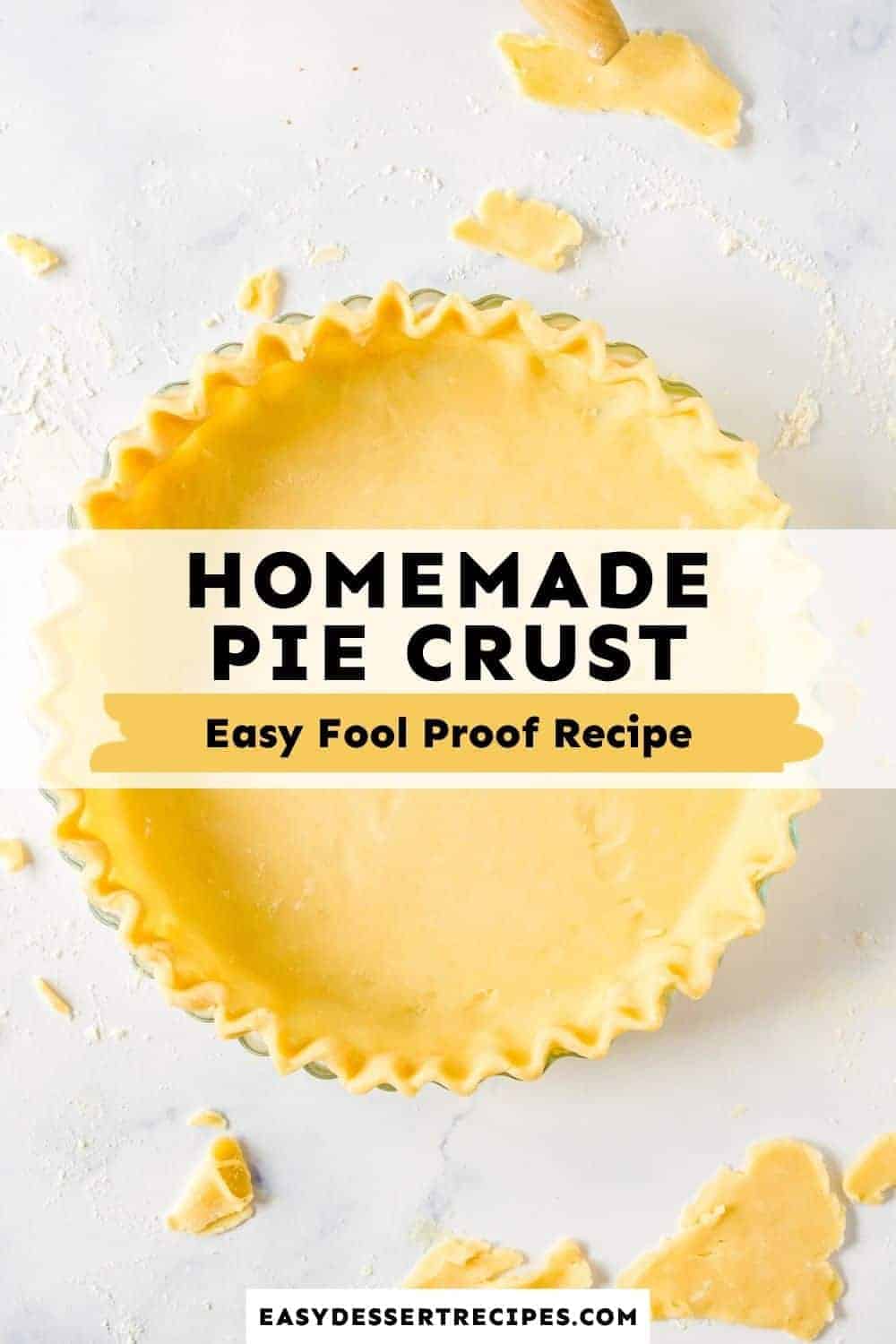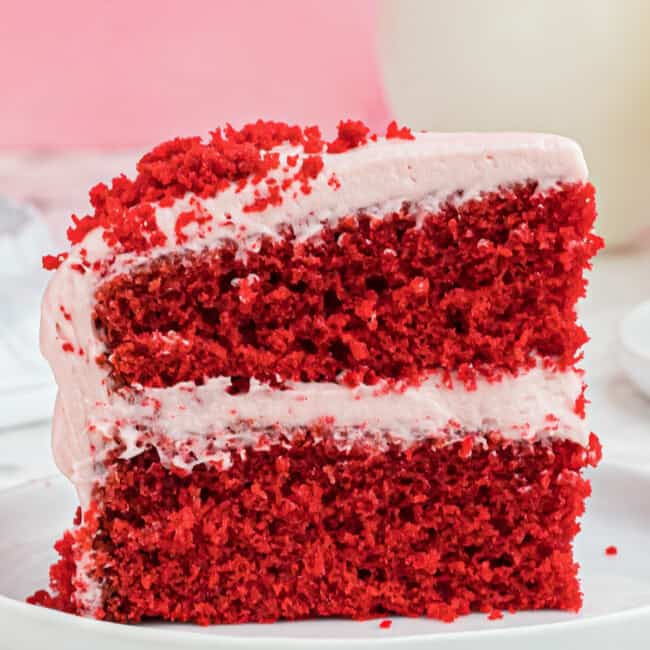Learn how to make flaky pie crust from scratch with this Easy Pie Crust Recipe that utilizes a food processor. This is the perfect baking skill to master, so you can make all the best homemade pies!

What’s in this Pie Crust Recipe?
Armed with a food processor, rolling pin, and just a few pantry ingredients, you’ll be making perfect flaky pies in no time!
- All-Purpose Flour: I designed this recipe to use all-purpose, but pastry flour also works.
- Unsalted Butter: Cut it into small cubes and keep it chilled until ready to use. You don’t want warm or melted butter.
- Vegetable Shortening: Same as with the butter, cut it into cubes and keep it chilled.
- Cold Water: Helps bring the dough together. Add an ice cube to the water to keep it cold.
- Kosher Salt: Enhances the flavor of the dough.
- Granulated Sugar: This is optional, but a little bit of sugar in the pie dough actually helps keep it tender and also enhances the flavor ever so slightly.
Pro Tip: It’s very important that the ingredients are very cold. As soon as it gets slightly warm, it needs to get back to the fridge to chill again.
How to Bake Homemade Pie Crust
Once your dough has been made and you’ve formed it into the perfect crust, you’ll need to bake it. But exactly how depends on what kind of pie you’re making.
Here’s a quick overview of baking times:
- Blind Baking (partially cooking, without filling): Cook at 425°F for 12-15 minutes.
- Fully Baking (with filling): First, blind-bake the crust as detailed above. Then, add your filling and bake at 375°F for 15-20 minutes.
- Fully Baking (no blind baking): Cook the pie crust at 375°F for 45 minutes.


Email This Recipe
Enter your email and we’ll send the recipe directly to you!
My number one tip for getting a perfectly flaky pie crust is to make sure you don’t overwork the dough. When mixing the dough, you should still see small pea-sized amounts of fat (butter and shortening) in there. Keeping the dough cool will also help create a more tender, flaky crust. You don’t want the fats to melt before they make it to the oven to cook, so be sure to put your ingredients/dough back in the fridge any time they start getting warm.
Butter has the best flavor, but it warms up easily and can be hard to work with. Using a combination of vegetable shortening and butter gives us the great flavor of butter with the stability and flexibility of shortening.
Creating that classic crimped/scalloped design around the edges of the crust is easy. Place your index finger on one side of the dough, then use the index finger and thumb of your other hand to “crimp” the dough from the other side. You are basically just using one finger to push the dough while pinching with your other finger/thumb. It takes a little bit of practice to get the motion right, but then it becomes really easy to do quickly.
Yes! You should chill your pie crust after just about every step! This ensures that the fat will melt slowly in the oven, releasing moisture and creating a flaky pie crust. Warm fat will melt out too quickly, leading to a greasy, flat crust.
If your pie crust shrinks while cooking, it most likely means you didn’t give it enough time to rest. The best way to prevent this is simply to give it the times it needs. This is why you need to give it time to rest/chill in the refrigerator after you make the dough and right before baking.

How to Make Ahead and Store
You have a few options for making and storing pie crust. After step 5, you can leave the dough in the refrigerator for up to 3 days, or you can continue through step 12 and then store the crust in the refrigerator for up to 3 days.
You can also blind-bake the pie crust and store it in the refrigerator for up to 3 days.
How to Freeze
If you want to freeze the crust, you can either freeze the dough or freeze the crust after blind baking for up to 3 months. Simply wrap the dough (or crust) in plastic wrap to prevent freezer burn. Let thaw overnight in the refrigerator before using.
Serving Suggestions
You can use this as the starting point for any pie you like! Some of my favorites include buttermilk pie, strawberry jello pie, coconut cream pie, chocolate cream pie, banana cream pie, homemade apple pie, cherry pie, and pumpkin pie.


Easy Pie Crust Recipe

Email This Recipe
Enter your email and we’ll send the recipe directly to you!
Ingredients
- 1⅓ cups all-purpose flour 160 grams, divided
- ½ teaspoon kosher salt
- 1 tablespoon granulated sugar 4 grams, optional
- 6 tablespoons unsalted butter 85 grams, chilled and cubed (¾ stick)
- ¼ cup vegetable shortening chilled and cubed (¼ stick)
- 2 tablespoons cold water 28 grams, see note 1
Equipment
- Kitchen Scale (optional)
- Food Processor
- Rolling Pin
- Pie Weights (optional)
Instructions
- Add ⅔ of the flour, salt, and sugar into your food processor. Pulse 1-2 times to combine.1⅓ cups all-purpose flour, ½ teaspoon kosher salt, 1 tablespoon granulated sugar
- Add the butter and shortening cubes evenly over the flour and pulse a couple of times until the dough starts coming together6 tablespoons unsalted butter, ¼ cup vegetable shortening
- Add the remaining flour and pulse 3-4 times until the dough starts to crumble and breaking apart again
- Transfer the dough to a bowl, add the cold water, 1 tablespoon at a time, and press the dough with a spatula until it comes together into a ball (see note 2).2 tablespoons cold water
- Press the dough into a flat circle, wrap it tightly in plastic wrap, and chill in the refrigerator for at least 2 hours or overnight (see note 3).
- When it's time to bake, roll out the dough carefully on a lightly-floured surface, moving it in quarter circles with your hands while rolling it out. Sprinkle some flour on the surface when needed to prevent sticking. Roll it out around 2 inches bigger than your pan
- Gently transfer the dough to the pan by adding some flour onto the surface and wrapping the dough carefully around your rolling pin
- Press the dough into the pan carefully so it's sticking to the pan everywhere
- Cut off excess overhanging dough with a sharp knife or some scissors, but leave around 1 inch of overhang.
- Roll the overlapping inch under itself to create a firmer and rim.
- Use your index finger and the index finger and thumb from the other hand to crimp the dough to form a scalloped edge (see note 4).
- Chill the pie crust again for at least 15 minutes before going on.
- If partially baking (blind baking), cook chilled pie crust at 425°F for 12-15 minutes without filling. You can use the pie weights as shown.
- If fully cooking, start by blind baking, then fill with your filling, and cook at 375°F for 15-20 minutes.
- If fully cooking WITHOUT blind baking, you can cook at 375°F for 45 minutes.
Notes
- Note 1: Put an ice cube into the water to keep it ice-cold
- Note 2: Don’t add too much water, the dough should just come together. You should use anywhere from 2-4 tablespoons.
- Note 3: It’s important to not incorporate the fats too much into the flour, you want to see little fat speckles in the dough. These will cause the flakiness of the dough.
- Note 4: Of course you can also form other crust patterns.
- You can also prepare the dough by hand using a fork or a pastry cutter to evenly work the fats into the flour until you see pea size pieces of fat covered in flour.
- It’s very important that the ingredients are very cold. As soon as it gets slightly warm, it needs to get back to the fridge to chill again.
- If the dough is too hard to roll out, let it sit on the counter for a couple of minutes. Too soft? Put it back into the fridge.
- The food processor is doing the work of cutting the butter and shortening into the flour. You can do this by hand with a pastry cutter or two forks, but the food processor will save you some time (and energy).
- Use baking beads/pie weights (or use dried beans) to blind bake the pie crust. These act as weights to hold down the dough, keep it from moving or slipping, and prevent it from puffing up while cooking.
- Sprinkle your counter/surface with flour before rolling out the dough to prevent it from sticking.
- Use just enough water to bring the dough together. Too much water, and you’ll need to add more flour to make up for it (which will lead to a tough crust). Not enough water, and the dough will be dry and start to crack while rolling it out. The latter can be fixed as you go, the former can’t. So be on the safe side when adding water, just a little at a time.
- Ingredients and dough should be kept cold/chilled through this whole process. If things start getting warm, put it in the fridge to chill before continuing.
- The scalloped or “crimped” pie crust is a simple design to start with as a beginner, but you can make any crust “design” you like with this dough.




























Leave a Review